Auditing and Assurance: ASA 701 Key Audit Matters Report Analysis
VerifiedAdded on 2022/09/09
|10
|3709
|14
Report
AI Summary
This report provides an in-depth analysis of the auditing standard ASA 701, focusing on the communication of Key Audit Matters (KAMs) in independent auditor's reports. The report examines the rationale behind ASA 701, highlighting its role in enhancing transparency and investor confidence by requiring auditors to disclose significant issues in financial statements. It analyzes the annual reports of major Australian banks, including ANZ, BOQ, Commonwealth Bank, Medibank, NAB, and Westpac, to assess how auditors have implemented ASA 701 and reported KAMs. The report discusses the audit procedures used to address key issues such as credit losses, financial instrument valuation, customer remediation, and IT system controls. It emphasizes the importance of clear and concise communication of KAMs, and the role of ASA 701 in improving financial reporting practices. The analysis includes the impact of the Enron collapse and the need for a uniform auditing standard. The conclusion offers recommendations based on the findings, emphasizing the significance of ASA 701 in promoting reliable financial reporting and informed decision-making.
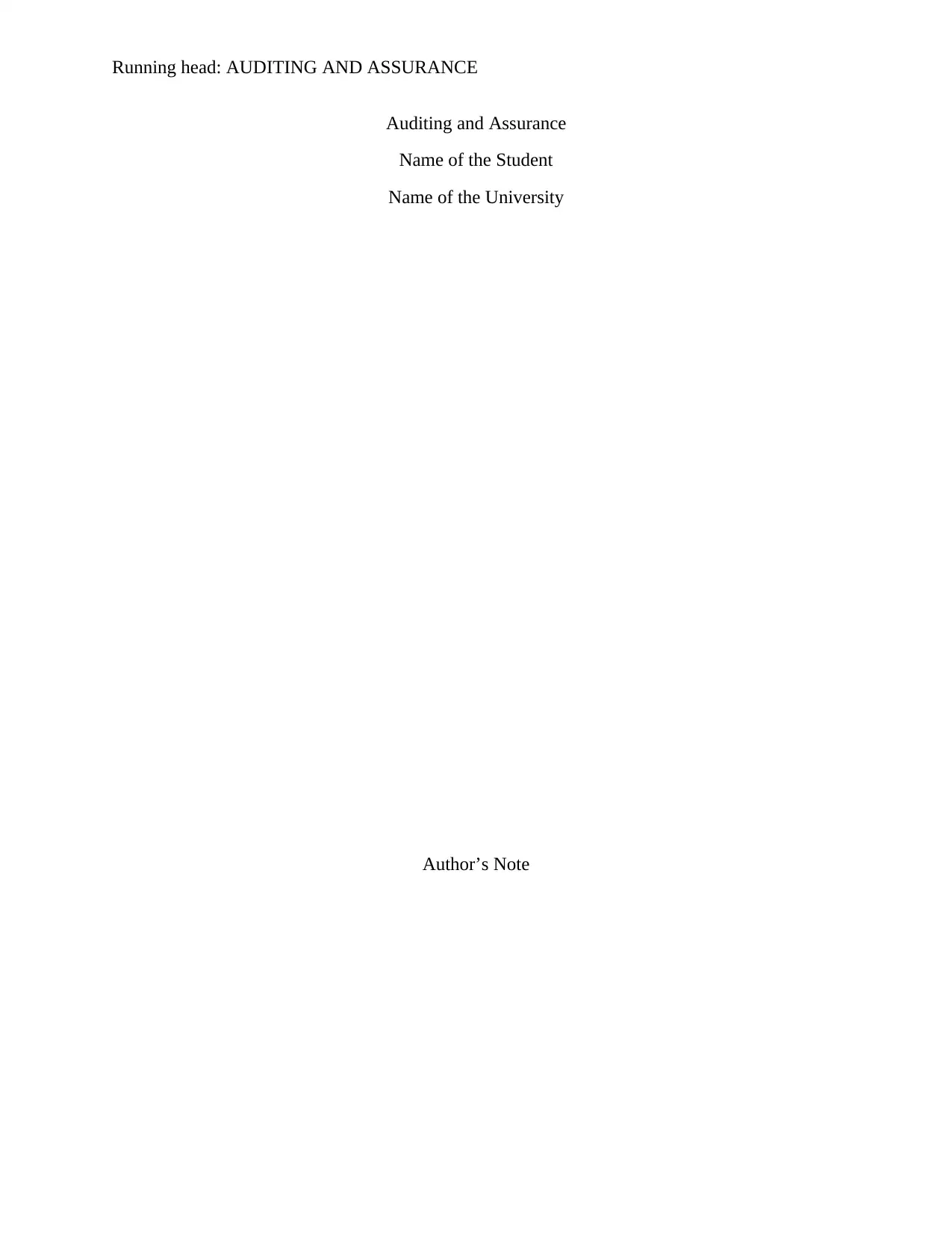
Running head: AUDITING AND ASSURANCE
Auditing and Assurance
Name of the Student
Name of the University
Author’s Note
Auditing and Assurance
Name of the Student
Name of the University
Author’s Note
Paraphrase This Document
Need a fresh take? Get an instant paraphrase of this document with our AI Paraphraser
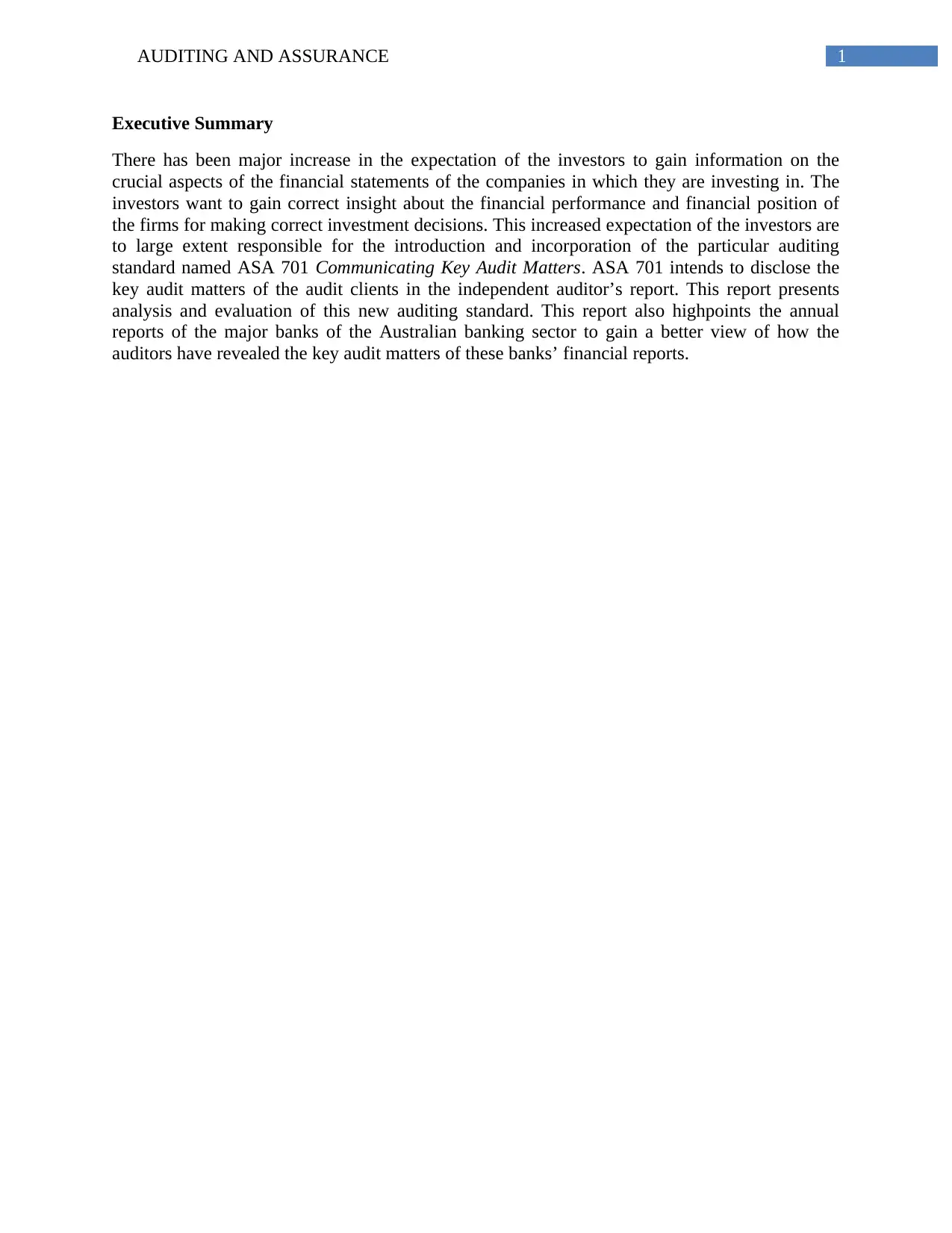
1AUDITING AND ASSURANCE
Executive Summary
There has been major increase in the expectation of the investors to gain information on the
crucial aspects of the financial statements of the companies in which they are investing in. The
investors want to gain correct insight about the financial performance and financial position of
the firms for making correct investment decisions. This increased expectation of the investors are
to large extent responsible for the introduction and incorporation of the particular auditing
standard named ASA 701 Communicating Key Audit Matters. ASA 701 intends to disclose the
key audit matters of the audit clients in the independent auditor’s report. This report presents
analysis and evaluation of this new auditing standard. This report also highpoints the annual
reports of the major banks of the Australian banking sector to gain a better view of how the
auditors have revealed the key audit matters of these banks’ financial reports.
Executive Summary
There has been major increase in the expectation of the investors to gain information on the
crucial aspects of the financial statements of the companies in which they are investing in. The
investors want to gain correct insight about the financial performance and financial position of
the firms for making correct investment decisions. This increased expectation of the investors are
to large extent responsible for the introduction and incorporation of the particular auditing
standard named ASA 701 Communicating Key Audit Matters. ASA 701 intends to disclose the
key audit matters of the audit clients in the independent auditor’s report. This report presents
analysis and evaluation of this new auditing standard. This report also highpoints the annual
reports of the major banks of the Australian banking sector to gain a better view of how the
auditors have revealed the key audit matters of these banks’ financial reports.
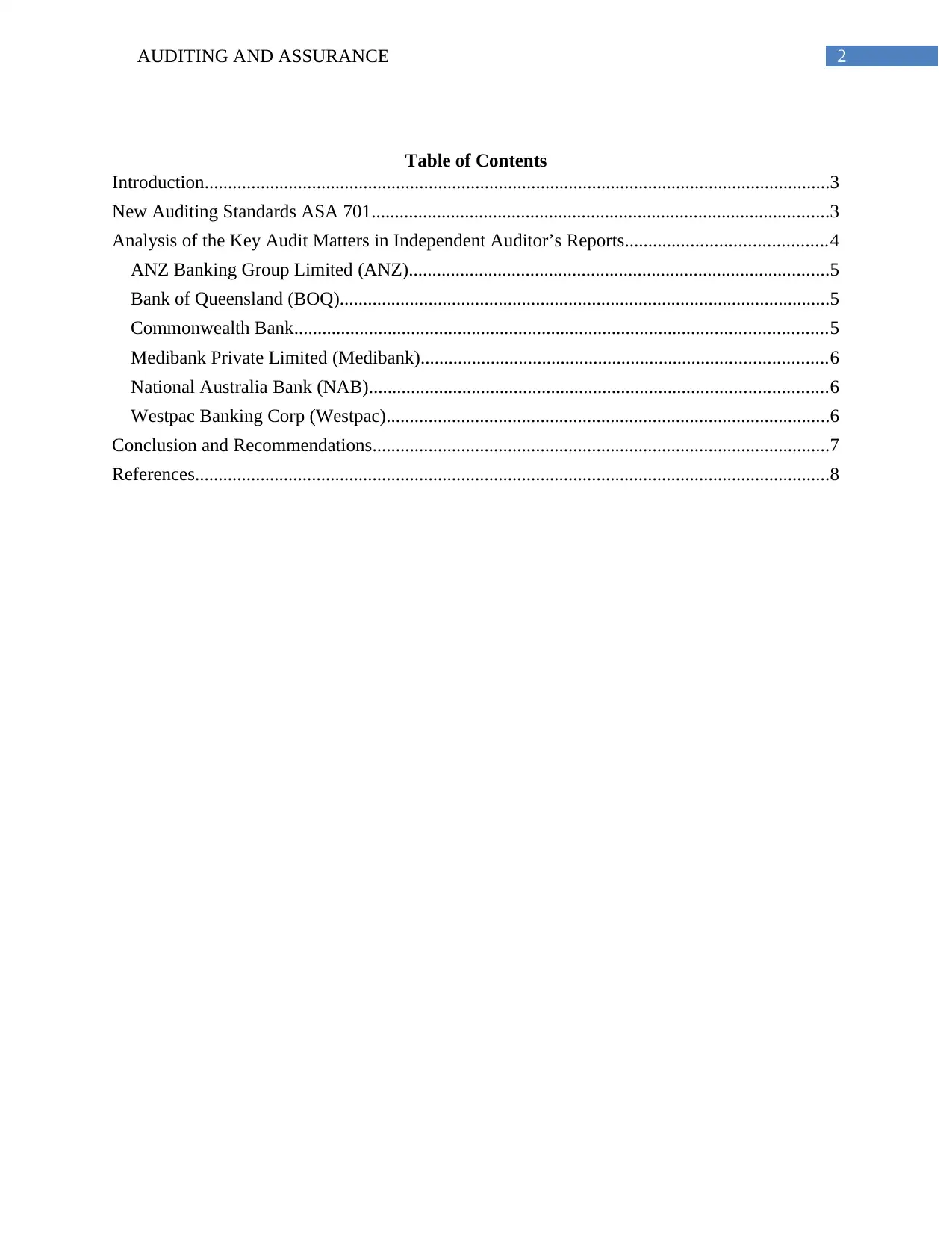
2AUDITING AND ASSURANCE
Table of Contents
Introduction......................................................................................................................................3
New Auditing Standards ASA 701..................................................................................................3
Analysis of the Key Audit Matters in Independent Auditor’s Reports...........................................4
ANZ Banking Group Limited (ANZ)..........................................................................................5
Bank of Queensland (BOQ).........................................................................................................5
Commonwealth Bank..................................................................................................................5
Medibank Private Limited (Medibank).......................................................................................6
National Australia Bank (NAB)..................................................................................................6
Westpac Banking Corp (Westpac)...............................................................................................6
Conclusion and Recommendations..................................................................................................7
References........................................................................................................................................8
Table of Contents
Introduction......................................................................................................................................3
New Auditing Standards ASA 701..................................................................................................3
Analysis of the Key Audit Matters in Independent Auditor’s Reports...........................................4
ANZ Banking Group Limited (ANZ)..........................................................................................5
Bank of Queensland (BOQ).........................................................................................................5
Commonwealth Bank..................................................................................................................5
Medibank Private Limited (Medibank).......................................................................................6
National Australia Bank (NAB)..................................................................................................6
Westpac Banking Corp (Westpac)...............................................................................................6
Conclusion and Recommendations..................................................................................................7
References........................................................................................................................................8
⊘ This is a preview!⊘
Do you want full access?
Subscribe today to unlock all pages.

Trusted by 1+ million students worldwide
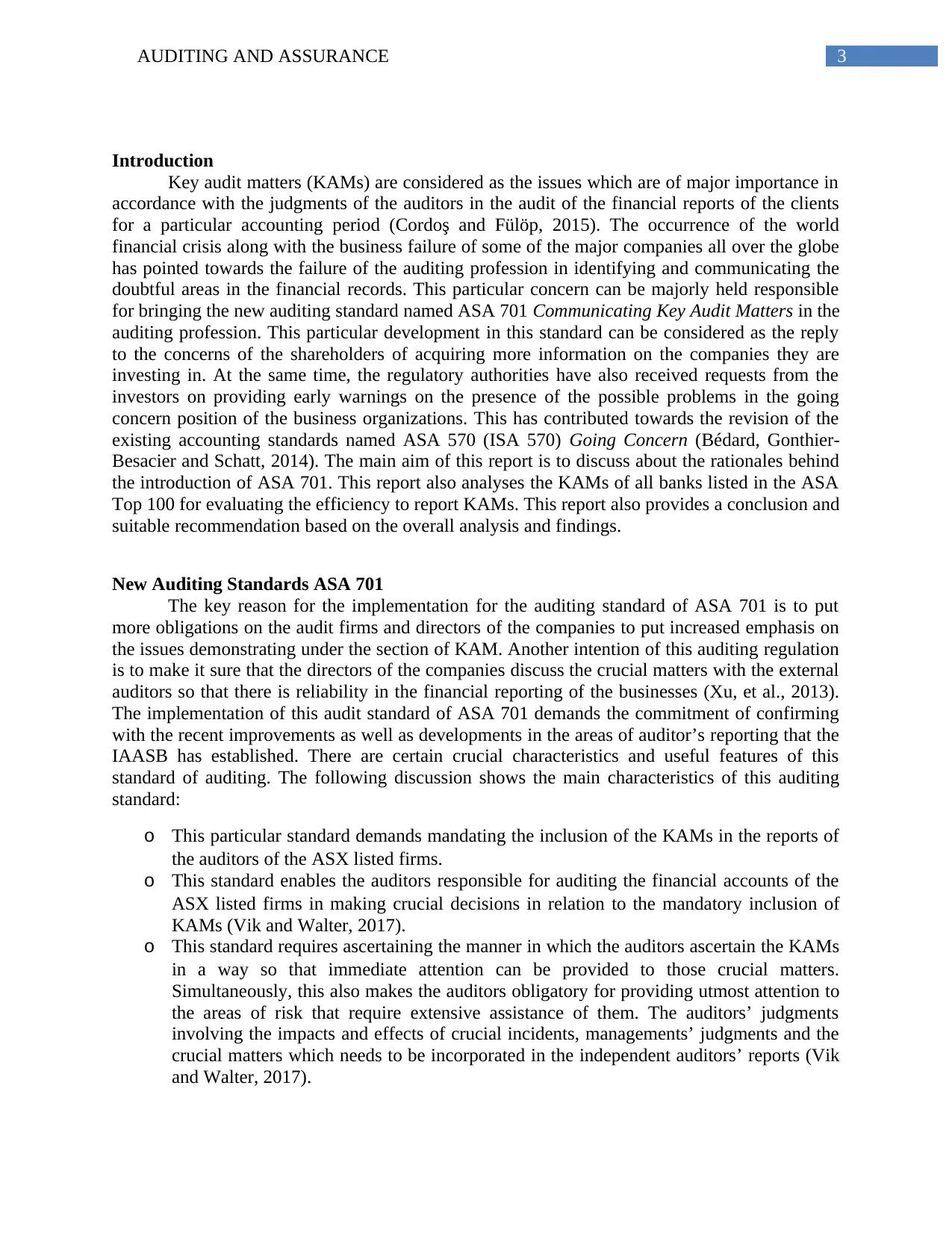
3AUDITING AND ASSURANCE
Introduction
Key audit matters (KAMs) are considered as the issues which are of major importance in
accordance with the judgments of the auditors in the audit of the financial reports of the clients
for a particular accounting period (Cordoş and Fülöp, 2015). The occurrence of the world
financial crisis along with the business failure of some of the major companies all over the globe
has pointed towards the failure of the auditing profession in identifying and communicating the
doubtful areas in the financial records. This particular concern can be majorly held responsible
for bringing the new auditing standard named ASA 701 Communicating Key Audit Matters in the
auditing profession. This particular development in this standard can be considered as the reply
to the concerns of the shareholders of acquiring more information on the companies they are
investing in. At the same time, the regulatory authorities have also received requests from the
investors on providing early warnings on the presence of the possible problems in the going
concern position of the business organizations. This has contributed towards the revision of the
existing accounting standards named ASA 570 (ISA 570) Going Concern (Bédard, Gonthier-
Besacier and Schatt, 2014). The main aim of this report is to discuss about the rationales behind
the introduction of ASA 701. This report also analyses the KAMs of all banks listed in the ASA
Top 100 for evaluating the efficiency to report KAMs. This report also provides a conclusion and
suitable recommendation based on the overall analysis and findings.
New Auditing Standards ASA 701
The key reason for the implementation for the auditing standard of ASA 701 is to put
more obligations on the audit firms and directors of the companies to put increased emphasis on
the issues demonstrating under the section of KAM. Another intention of this auditing regulation
is to make it sure that the directors of the companies discuss the crucial matters with the external
auditors so that there is reliability in the financial reporting of the businesses (Xu, et al., 2013).
The implementation of this audit standard of ASA 701 demands the commitment of confirming
with the recent improvements as well as developments in the areas of auditor’s reporting that the
IAASB has established. There are certain crucial characteristics and useful features of this
standard of auditing. The following discussion shows the main characteristics of this auditing
standard:
o This particular standard demands mandating the inclusion of the KAMs in the reports of
the auditors of the ASX listed firms.
o This standard enables the auditors responsible for auditing the financial accounts of the
ASX listed firms in making crucial decisions in relation to the mandatory inclusion of
KAMs (Vik and Walter, 2017).
o This standard requires ascertaining the manner in which the auditors ascertain the KAMs
in a way so that immediate attention can be provided to those crucial matters.
Simultaneously, this also makes the auditors obligatory for providing utmost attention to
the areas of risk that require extensive assistance of them. The auditors’ judgments
involving the impacts and effects of crucial incidents, managements’ judgments and the
crucial matters which needs to be incorporated in the independent auditors’ reports (Vik
and Walter, 2017).
Introduction
Key audit matters (KAMs) are considered as the issues which are of major importance in
accordance with the judgments of the auditors in the audit of the financial reports of the clients
for a particular accounting period (Cordoş and Fülöp, 2015). The occurrence of the world
financial crisis along with the business failure of some of the major companies all over the globe
has pointed towards the failure of the auditing profession in identifying and communicating the
doubtful areas in the financial records. This particular concern can be majorly held responsible
for bringing the new auditing standard named ASA 701 Communicating Key Audit Matters in the
auditing profession. This particular development in this standard can be considered as the reply
to the concerns of the shareholders of acquiring more information on the companies they are
investing in. At the same time, the regulatory authorities have also received requests from the
investors on providing early warnings on the presence of the possible problems in the going
concern position of the business organizations. This has contributed towards the revision of the
existing accounting standards named ASA 570 (ISA 570) Going Concern (Bédard, Gonthier-
Besacier and Schatt, 2014). The main aim of this report is to discuss about the rationales behind
the introduction of ASA 701. This report also analyses the KAMs of all banks listed in the ASA
Top 100 for evaluating the efficiency to report KAMs. This report also provides a conclusion and
suitable recommendation based on the overall analysis and findings.
New Auditing Standards ASA 701
The key reason for the implementation for the auditing standard of ASA 701 is to put
more obligations on the audit firms and directors of the companies to put increased emphasis on
the issues demonstrating under the section of KAM. Another intention of this auditing regulation
is to make it sure that the directors of the companies discuss the crucial matters with the external
auditors so that there is reliability in the financial reporting of the businesses (Xu, et al., 2013).
The implementation of this audit standard of ASA 701 demands the commitment of confirming
with the recent improvements as well as developments in the areas of auditor’s reporting that the
IAASB has established. There are certain crucial characteristics and useful features of this
standard of auditing. The following discussion shows the main characteristics of this auditing
standard:
o This particular standard demands mandating the inclusion of the KAMs in the reports of
the auditors of the ASX listed firms.
o This standard enables the auditors responsible for auditing the financial accounts of the
ASX listed firms in making crucial decisions in relation to the mandatory inclusion of
KAMs (Vik and Walter, 2017).
o This standard requires ascertaining the manner in which the auditors ascertain the KAMs
in a way so that immediate attention can be provided to those crucial matters.
Simultaneously, this also makes the auditors obligatory for providing utmost attention to
the areas of risk that require extensive assistance of them. The auditors’ judgments
involving the impacts and effects of crucial incidents, managements’ judgments and the
crucial matters which needs to be incorporated in the independent auditors’ reports (Vik
and Walter, 2017).
Paraphrase This Document
Need a fresh take? Get an instant paraphrase of this document with our AI Paraphraser
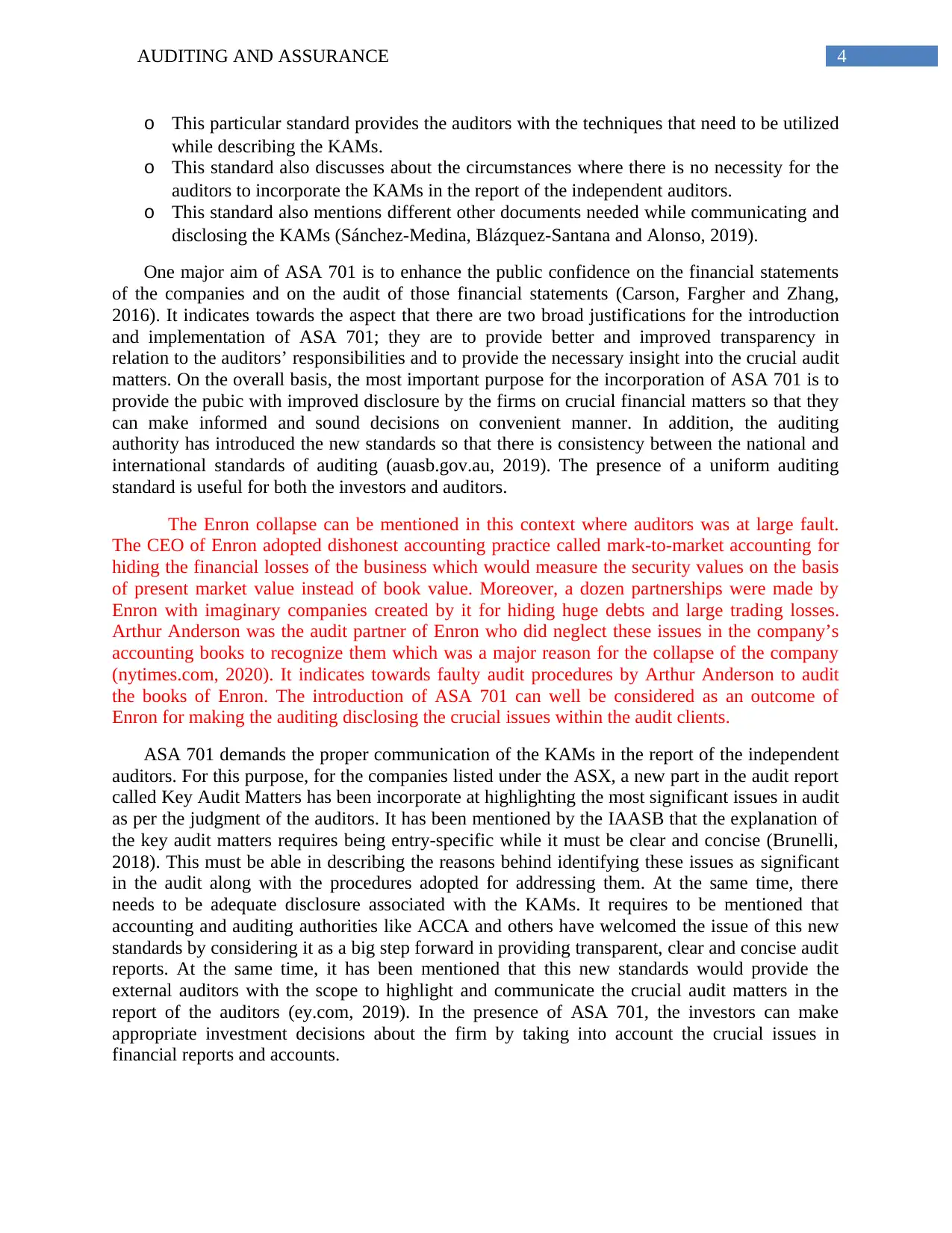
4AUDITING AND ASSURANCE
o This particular standard provides the auditors with the techniques that need to be utilized
while describing the KAMs.
o This standard also discusses about the circumstances where there is no necessity for the
auditors to incorporate the KAMs in the report of the independent auditors.
o This standard also mentions different other documents needed while communicating and
disclosing the KAMs (Sánchez-Medina, Blázquez-Santana and Alonso, 2019).
One major aim of ASA 701 is to enhance the public confidence on the financial statements
of the companies and on the audit of those financial statements (Carson, Fargher and Zhang,
2016). It indicates towards the aspect that there are two broad justifications for the introduction
and implementation of ASA 701; they are to provide better and improved transparency in
relation to the auditors’ responsibilities and to provide the necessary insight into the crucial audit
matters. On the overall basis, the most important purpose for the incorporation of ASA 701 is to
provide the pubic with improved disclosure by the firms on crucial financial matters so that they
can make informed and sound decisions on convenient manner. In addition, the auditing
authority has introduced the new standards so that there is consistency between the national and
international standards of auditing (auasb.gov.au, 2019). The presence of a uniform auditing
standard is useful for both the investors and auditors.
The Enron collapse can be mentioned in this context where auditors was at large fault.
The CEO of Enron adopted dishonest accounting practice called mark-to-market accounting for
hiding the financial losses of the business which would measure the security values on the basis
of present market value instead of book value. Moreover, a dozen partnerships were made by
Enron with imaginary companies created by it for hiding huge debts and large trading losses.
Arthur Anderson was the audit partner of Enron who did neglect these issues in the company’s
accounting books to recognize them which was a major reason for the collapse of the company
(nytimes.com, 2020). It indicates towards faulty audit procedures by Arthur Anderson to audit
the books of Enron. The introduction of ASA 701 can well be considered as an outcome of
Enron for making the auditing disclosing the crucial issues within the audit clients.
ASA 701 demands the proper communication of the KAMs in the report of the independent
auditors. For this purpose, for the companies listed under the ASX, a new part in the audit report
called Key Audit Matters has been incorporate at highlighting the most significant issues in audit
as per the judgment of the auditors. It has been mentioned by the IAASB that the explanation of
the key audit matters requires being entry-specific while it must be clear and concise (Brunelli,
2018). This must be able in describing the reasons behind identifying these issues as significant
in the audit along with the procedures adopted for addressing them. At the same time, there
needs to be adequate disclosure associated with the KAMs. It requires to be mentioned that
accounting and auditing authorities like ACCA and others have welcomed the issue of this new
standards by considering it as a big step forward in providing transparent, clear and concise audit
reports. At the same time, it has been mentioned that this new standards would provide the
external auditors with the scope to highlight and communicate the crucial audit matters in the
report of the auditors (ey.com, 2019). In the presence of ASA 701, the investors can make
appropriate investment decisions about the firm by taking into account the crucial issues in
financial reports and accounts.
o This particular standard provides the auditors with the techniques that need to be utilized
while describing the KAMs.
o This standard also discusses about the circumstances where there is no necessity for the
auditors to incorporate the KAMs in the report of the independent auditors.
o This standard also mentions different other documents needed while communicating and
disclosing the KAMs (Sánchez-Medina, Blázquez-Santana and Alonso, 2019).
One major aim of ASA 701 is to enhance the public confidence on the financial statements
of the companies and on the audit of those financial statements (Carson, Fargher and Zhang,
2016). It indicates towards the aspect that there are two broad justifications for the introduction
and implementation of ASA 701; they are to provide better and improved transparency in
relation to the auditors’ responsibilities and to provide the necessary insight into the crucial audit
matters. On the overall basis, the most important purpose for the incorporation of ASA 701 is to
provide the pubic with improved disclosure by the firms on crucial financial matters so that they
can make informed and sound decisions on convenient manner. In addition, the auditing
authority has introduced the new standards so that there is consistency between the national and
international standards of auditing (auasb.gov.au, 2019). The presence of a uniform auditing
standard is useful for both the investors and auditors.
The Enron collapse can be mentioned in this context where auditors was at large fault.
The CEO of Enron adopted dishonest accounting practice called mark-to-market accounting for
hiding the financial losses of the business which would measure the security values on the basis
of present market value instead of book value. Moreover, a dozen partnerships were made by
Enron with imaginary companies created by it for hiding huge debts and large trading losses.
Arthur Anderson was the audit partner of Enron who did neglect these issues in the company’s
accounting books to recognize them which was a major reason for the collapse of the company
(nytimes.com, 2020). It indicates towards faulty audit procedures by Arthur Anderson to audit
the books of Enron. The introduction of ASA 701 can well be considered as an outcome of
Enron for making the auditing disclosing the crucial issues within the audit clients.
ASA 701 demands the proper communication of the KAMs in the report of the independent
auditors. For this purpose, for the companies listed under the ASX, a new part in the audit report
called Key Audit Matters has been incorporate at highlighting the most significant issues in audit
as per the judgment of the auditors. It has been mentioned by the IAASB that the explanation of
the key audit matters requires being entry-specific while it must be clear and concise (Brunelli,
2018). This must be able in describing the reasons behind identifying these issues as significant
in the audit along with the procedures adopted for addressing them. At the same time, there
needs to be adequate disclosure associated with the KAMs. It requires to be mentioned that
accounting and auditing authorities like ACCA and others have welcomed the issue of this new
standards by considering it as a big step forward in providing transparent, clear and concise audit
reports. At the same time, it has been mentioned that this new standards would provide the
external auditors with the scope to highlight and communicate the crucial audit matters in the
report of the auditors (ey.com, 2019). In the presence of ASA 701, the investors can make
appropriate investment decisions about the firm by taking into account the crucial issues in
financial reports and accounts.
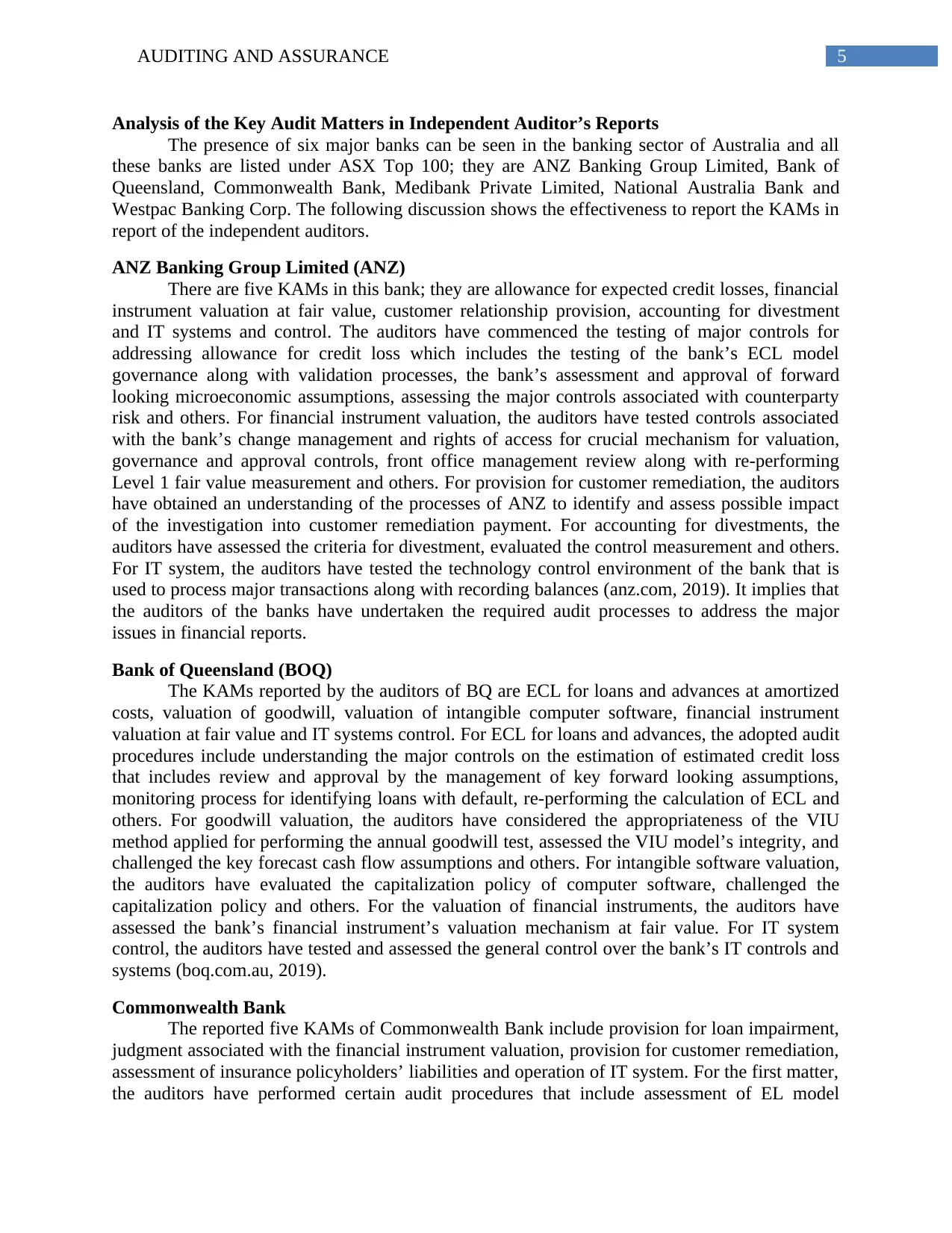
5AUDITING AND ASSURANCE
Analysis of the Key Audit Matters in Independent Auditor’s Reports
The presence of six major banks can be seen in the banking sector of Australia and all
these banks are listed under ASX Top 100; they are ANZ Banking Group Limited, Bank of
Queensland, Commonwealth Bank, Medibank Private Limited, National Australia Bank and
Westpac Banking Corp. The following discussion shows the effectiveness to report the KAMs in
report of the independent auditors.
ANZ Banking Group Limited (ANZ)
There are five KAMs in this bank; they are allowance for expected credit losses, financial
instrument valuation at fair value, customer relationship provision, accounting for divestment
and IT systems and control. The auditors have commenced the testing of major controls for
addressing allowance for credit loss which includes the testing of the bank’s ECL model
governance along with validation processes, the bank’s assessment and approval of forward
looking microeconomic assumptions, assessing the major controls associated with counterparty
risk and others. For financial instrument valuation, the auditors have tested controls associated
with the bank’s change management and rights of access for crucial mechanism for valuation,
governance and approval controls, front office management review along with re-performing
Level 1 fair value measurement and others. For provision for customer remediation, the auditors
have obtained an understanding of the processes of ANZ to identify and assess possible impact
of the investigation into customer remediation payment. For accounting for divestments, the
auditors have assessed the criteria for divestment, evaluated the control measurement and others.
For IT system, the auditors have tested the technology control environment of the bank that is
used to process major transactions along with recording balances (anz.com, 2019). It implies that
the auditors of the banks have undertaken the required audit processes to address the major
issues in financial reports.
Bank of Queensland (BOQ)
The KAMs reported by the auditors of BQ are ECL for loans and advances at amortized
costs, valuation of goodwill, valuation of intangible computer software, financial instrument
valuation at fair value and IT systems control. For ECL for loans and advances, the adopted audit
procedures include understanding the major controls on the estimation of estimated credit loss
that includes review and approval by the management of key forward looking assumptions,
monitoring process for identifying loans with default, re-performing the calculation of ECL and
others. For goodwill valuation, the auditors have considered the appropriateness of the VIU
method applied for performing the annual goodwill test, assessed the VIU model’s integrity, and
challenged the key forecast cash flow assumptions and others. For intangible software valuation,
the auditors have evaluated the capitalization policy of computer software, challenged the
capitalization policy and others. For the valuation of financial instruments, the auditors have
assessed the bank’s financial instrument’s valuation mechanism at fair value. For IT system
control, the auditors have tested and assessed the general control over the bank’s IT controls and
systems (boq.com.au, 2019).
Commonwealth Bank
The reported five KAMs of Commonwealth Bank include provision for loan impairment,
judgment associated with the financial instrument valuation, provision for customer remediation,
assessment of insurance policyholders’ liabilities and operation of IT system. For the first matter,
the auditors have performed certain audit procedures that include assessment of EL model
Analysis of the Key Audit Matters in Independent Auditor’s Reports
The presence of six major banks can be seen in the banking sector of Australia and all
these banks are listed under ASX Top 100; they are ANZ Banking Group Limited, Bank of
Queensland, Commonwealth Bank, Medibank Private Limited, National Australia Bank and
Westpac Banking Corp. The following discussion shows the effectiveness to report the KAMs in
report of the independent auditors.
ANZ Banking Group Limited (ANZ)
There are five KAMs in this bank; they are allowance for expected credit losses, financial
instrument valuation at fair value, customer relationship provision, accounting for divestment
and IT systems and control. The auditors have commenced the testing of major controls for
addressing allowance for credit loss which includes the testing of the bank’s ECL model
governance along with validation processes, the bank’s assessment and approval of forward
looking microeconomic assumptions, assessing the major controls associated with counterparty
risk and others. For financial instrument valuation, the auditors have tested controls associated
with the bank’s change management and rights of access for crucial mechanism for valuation,
governance and approval controls, front office management review along with re-performing
Level 1 fair value measurement and others. For provision for customer remediation, the auditors
have obtained an understanding of the processes of ANZ to identify and assess possible impact
of the investigation into customer remediation payment. For accounting for divestments, the
auditors have assessed the criteria for divestment, evaluated the control measurement and others.
For IT system, the auditors have tested the technology control environment of the bank that is
used to process major transactions along with recording balances (anz.com, 2019). It implies that
the auditors of the banks have undertaken the required audit processes to address the major
issues in financial reports.
Bank of Queensland (BOQ)
The KAMs reported by the auditors of BQ are ECL for loans and advances at amortized
costs, valuation of goodwill, valuation of intangible computer software, financial instrument
valuation at fair value and IT systems control. For ECL for loans and advances, the adopted audit
procedures include understanding the major controls on the estimation of estimated credit loss
that includes review and approval by the management of key forward looking assumptions,
monitoring process for identifying loans with default, re-performing the calculation of ECL and
others. For goodwill valuation, the auditors have considered the appropriateness of the VIU
method applied for performing the annual goodwill test, assessed the VIU model’s integrity, and
challenged the key forecast cash flow assumptions and others. For intangible software valuation,
the auditors have evaluated the capitalization policy of computer software, challenged the
capitalization policy and others. For the valuation of financial instruments, the auditors have
assessed the bank’s financial instrument’s valuation mechanism at fair value. For IT system
control, the auditors have tested and assessed the general control over the bank’s IT controls and
systems (boq.com.au, 2019).
Commonwealth Bank
The reported five KAMs of Commonwealth Bank include provision for loan impairment,
judgment associated with the financial instrument valuation, provision for customer remediation,
assessment of insurance policyholders’ liabilities and operation of IT system. For the first matter,
the auditors have performed certain audit procedures that include assessment of EL model
⊘ This is a preview!⊘
Do you want full access?
Subscribe today to unlock all pages.

Trusted by 1+ million students worldwide
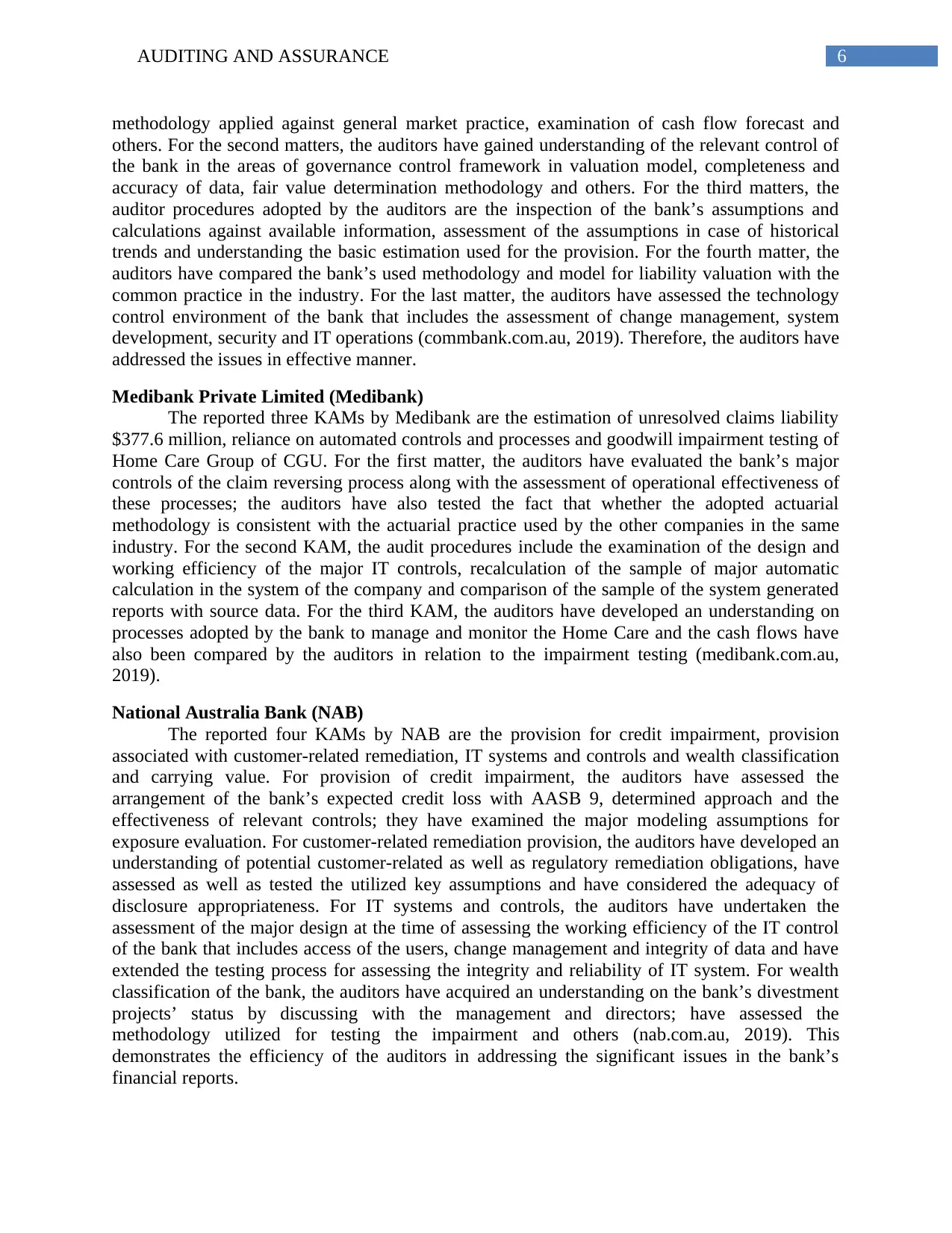
6AUDITING AND ASSURANCE
methodology applied against general market practice, examination of cash flow forecast and
others. For the second matters, the auditors have gained understanding of the relevant control of
the bank in the areas of governance control framework in valuation model, completeness and
accuracy of data, fair value determination methodology and others. For the third matters, the
auditor procedures adopted by the auditors are the inspection of the bank’s assumptions and
calculations against available information, assessment of the assumptions in case of historical
trends and understanding the basic estimation used for the provision. For the fourth matter, the
auditors have compared the bank’s used methodology and model for liability valuation with the
common practice in the industry. For the last matter, the auditors have assessed the technology
control environment of the bank that includes the assessment of change management, system
development, security and IT operations (commbank.com.au, 2019). Therefore, the auditors have
addressed the issues in effective manner.
Medibank Private Limited (Medibank)
The reported three KAMs by Medibank are the estimation of unresolved claims liability
$377.6 million, reliance on automated controls and processes and goodwill impairment testing of
Home Care Group of CGU. For the first matter, the auditors have evaluated the bank’s major
controls of the claim reversing process along with the assessment of operational effectiveness of
these processes; the auditors have also tested the fact that whether the adopted actuarial
methodology is consistent with the actuarial practice used by the other companies in the same
industry. For the second KAM, the audit procedures include the examination of the design and
working efficiency of the major IT controls, recalculation of the sample of major automatic
calculation in the system of the company and comparison of the sample of the system generated
reports with source data. For the third KAM, the auditors have developed an understanding on
processes adopted by the bank to manage and monitor the Home Care and the cash flows have
also been compared by the auditors in relation to the impairment testing (medibank.com.au,
2019).
National Australia Bank (NAB)
The reported four KAMs by NAB are the provision for credit impairment, provision
associated with customer-related remediation, IT systems and controls and wealth classification
and carrying value. For provision of credit impairment, the auditors have assessed the
arrangement of the bank’s expected credit loss with AASB 9, determined approach and the
effectiveness of relevant controls; they have examined the major modeling assumptions for
exposure evaluation. For customer-related remediation provision, the auditors have developed an
understanding of potential customer-related as well as regulatory remediation obligations, have
assessed as well as tested the utilized key assumptions and have considered the adequacy of
disclosure appropriateness. For IT systems and controls, the auditors have undertaken the
assessment of the major design at the time of assessing the working efficiency of the IT control
of the bank that includes access of the users, change management and integrity of data and have
extended the testing process for assessing the integrity and reliability of IT system. For wealth
classification of the bank, the auditors have acquired an understanding on the bank’s divestment
projects’ status by discussing with the management and directors; have assessed the
methodology utilized for testing the impairment and others (nab.com.au, 2019). This
demonstrates the efficiency of the auditors in addressing the significant issues in the bank’s
financial reports.
methodology applied against general market practice, examination of cash flow forecast and
others. For the second matters, the auditors have gained understanding of the relevant control of
the bank in the areas of governance control framework in valuation model, completeness and
accuracy of data, fair value determination methodology and others. For the third matters, the
auditor procedures adopted by the auditors are the inspection of the bank’s assumptions and
calculations against available information, assessment of the assumptions in case of historical
trends and understanding the basic estimation used for the provision. For the fourth matter, the
auditors have compared the bank’s used methodology and model for liability valuation with the
common practice in the industry. For the last matter, the auditors have assessed the technology
control environment of the bank that includes the assessment of change management, system
development, security and IT operations (commbank.com.au, 2019). Therefore, the auditors have
addressed the issues in effective manner.
Medibank Private Limited (Medibank)
The reported three KAMs by Medibank are the estimation of unresolved claims liability
$377.6 million, reliance on automated controls and processes and goodwill impairment testing of
Home Care Group of CGU. For the first matter, the auditors have evaluated the bank’s major
controls of the claim reversing process along with the assessment of operational effectiveness of
these processes; the auditors have also tested the fact that whether the adopted actuarial
methodology is consistent with the actuarial practice used by the other companies in the same
industry. For the second KAM, the audit procedures include the examination of the design and
working efficiency of the major IT controls, recalculation of the sample of major automatic
calculation in the system of the company and comparison of the sample of the system generated
reports with source data. For the third KAM, the auditors have developed an understanding on
processes adopted by the bank to manage and monitor the Home Care and the cash flows have
also been compared by the auditors in relation to the impairment testing (medibank.com.au,
2019).
National Australia Bank (NAB)
The reported four KAMs by NAB are the provision for credit impairment, provision
associated with customer-related remediation, IT systems and controls and wealth classification
and carrying value. For provision of credit impairment, the auditors have assessed the
arrangement of the bank’s expected credit loss with AASB 9, determined approach and the
effectiveness of relevant controls; they have examined the major modeling assumptions for
exposure evaluation. For customer-related remediation provision, the auditors have developed an
understanding of potential customer-related as well as regulatory remediation obligations, have
assessed as well as tested the utilized key assumptions and have considered the adequacy of
disclosure appropriateness. For IT systems and controls, the auditors have undertaken the
assessment of the major design at the time of assessing the working efficiency of the IT control
of the bank that includes access of the users, change management and integrity of data and have
extended the testing process for assessing the integrity and reliability of IT system. For wealth
classification of the bank, the auditors have acquired an understanding on the bank’s divestment
projects’ status by discussing with the management and directors; have assessed the
methodology utilized for testing the impairment and others (nab.com.au, 2019). This
demonstrates the efficiency of the auditors in addressing the significant issues in the bank’s
financial reports.
Paraphrase This Document
Need a fresh take? Get an instant paraphrase of this document with our AI Paraphraser
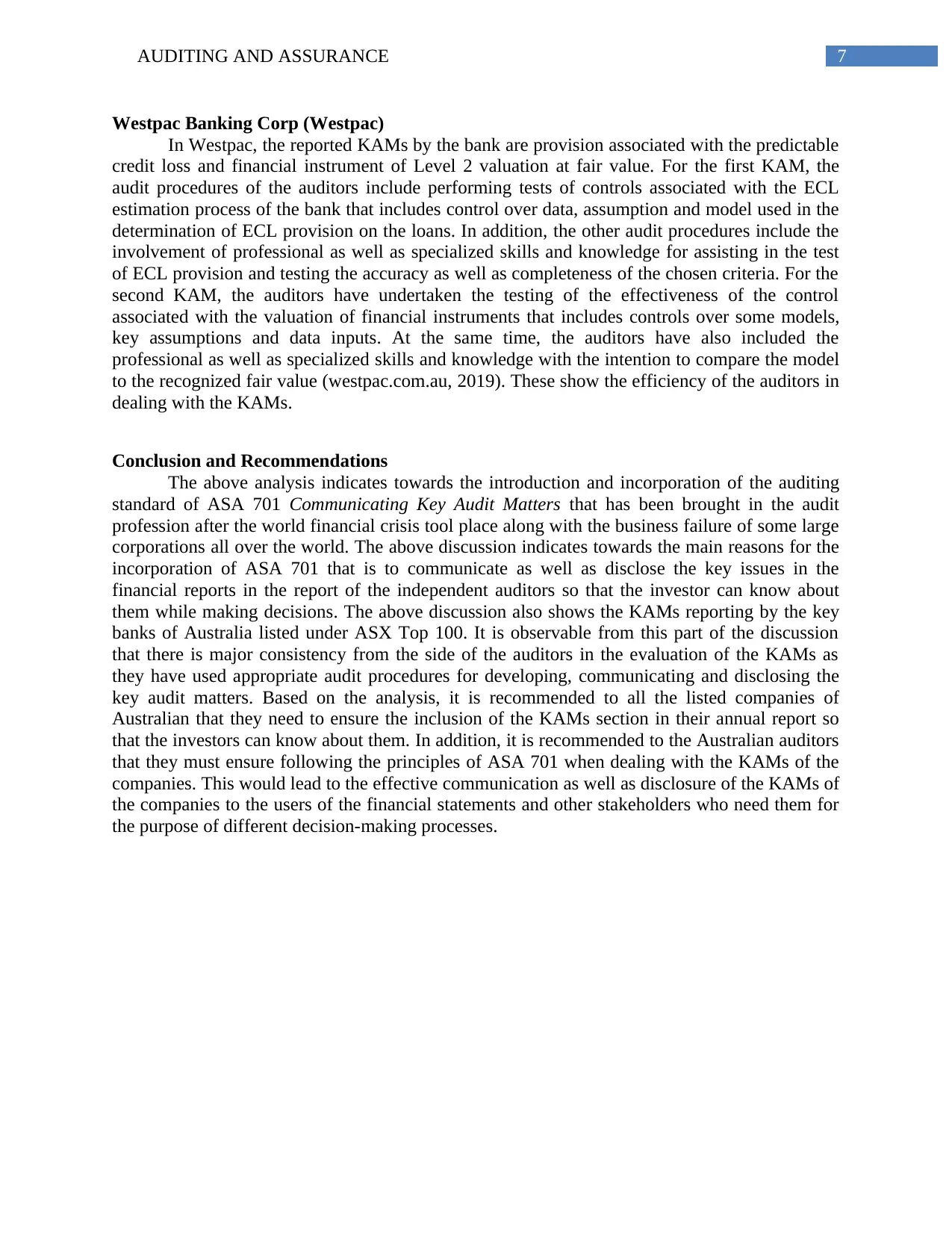
7AUDITING AND ASSURANCE
Westpac Banking Corp (Westpac)
In Westpac, the reported KAMs by the bank are provision associated with the predictable
credit loss and financial instrument of Level 2 valuation at fair value. For the first KAM, the
audit procedures of the auditors include performing tests of controls associated with the ECL
estimation process of the bank that includes control over data, assumption and model used in the
determination of ECL provision on the loans. In addition, the other audit procedures include the
involvement of professional as well as specialized skills and knowledge for assisting in the test
of ECL provision and testing the accuracy as well as completeness of the chosen criteria. For the
second KAM, the auditors have undertaken the testing of the effectiveness of the control
associated with the valuation of financial instruments that includes controls over some models,
key assumptions and data inputs. At the same time, the auditors have also included the
professional as well as specialized skills and knowledge with the intention to compare the model
to the recognized fair value (westpac.com.au, 2019). These show the efficiency of the auditors in
dealing with the KAMs.
Conclusion and Recommendations
The above analysis indicates towards the introduction and incorporation of the auditing
standard of ASA 701 Communicating Key Audit Matters that has been brought in the audit
profession after the world financial crisis tool place along with the business failure of some large
corporations all over the world. The above discussion indicates towards the main reasons for the
incorporation of ASA 701 that is to communicate as well as disclose the key issues in the
financial reports in the report of the independent auditors so that the investor can know about
them while making decisions. The above discussion also shows the KAMs reporting by the key
banks of Australia listed under ASX Top 100. It is observable from this part of the discussion
that there is major consistency from the side of the auditors in the evaluation of the KAMs as
they have used appropriate audit procedures for developing, communicating and disclosing the
key audit matters. Based on the analysis, it is recommended to all the listed companies of
Australian that they need to ensure the inclusion of the KAMs section in their annual report so
that the investors can know about them. In addition, it is recommended to the Australian auditors
that they must ensure following the principles of ASA 701 when dealing with the KAMs of the
companies. This would lead to the effective communication as well as disclosure of the KAMs of
the companies to the users of the financial statements and other stakeholders who need them for
the purpose of different decision-making processes.
Westpac Banking Corp (Westpac)
In Westpac, the reported KAMs by the bank are provision associated with the predictable
credit loss and financial instrument of Level 2 valuation at fair value. For the first KAM, the
audit procedures of the auditors include performing tests of controls associated with the ECL
estimation process of the bank that includes control over data, assumption and model used in the
determination of ECL provision on the loans. In addition, the other audit procedures include the
involvement of professional as well as specialized skills and knowledge for assisting in the test
of ECL provision and testing the accuracy as well as completeness of the chosen criteria. For the
second KAM, the auditors have undertaken the testing of the effectiveness of the control
associated with the valuation of financial instruments that includes controls over some models,
key assumptions and data inputs. At the same time, the auditors have also included the
professional as well as specialized skills and knowledge with the intention to compare the model
to the recognized fair value (westpac.com.au, 2019). These show the efficiency of the auditors in
dealing with the KAMs.
Conclusion and Recommendations
The above analysis indicates towards the introduction and incorporation of the auditing
standard of ASA 701 Communicating Key Audit Matters that has been brought in the audit
profession after the world financial crisis tool place along with the business failure of some large
corporations all over the world. The above discussion indicates towards the main reasons for the
incorporation of ASA 701 that is to communicate as well as disclose the key issues in the
financial reports in the report of the independent auditors so that the investor can know about
them while making decisions. The above discussion also shows the KAMs reporting by the key
banks of Australia listed under ASX Top 100. It is observable from this part of the discussion
that there is major consistency from the side of the auditors in the evaluation of the KAMs as
they have used appropriate audit procedures for developing, communicating and disclosing the
key audit matters. Based on the analysis, it is recommended to all the listed companies of
Australian that they need to ensure the inclusion of the KAMs section in their annual report so
that the investors can know about them. In addition, it is recommended to the Australian auditors
that they must ensure following the principles of ASA 701 when dealing with the KAMs of the
companies. This would lead to the effective communication as well as disclosure of the KAMs of
the companies to the users of the financial statements and other stakeholders who need them for
the purpose of different decision-making processes.
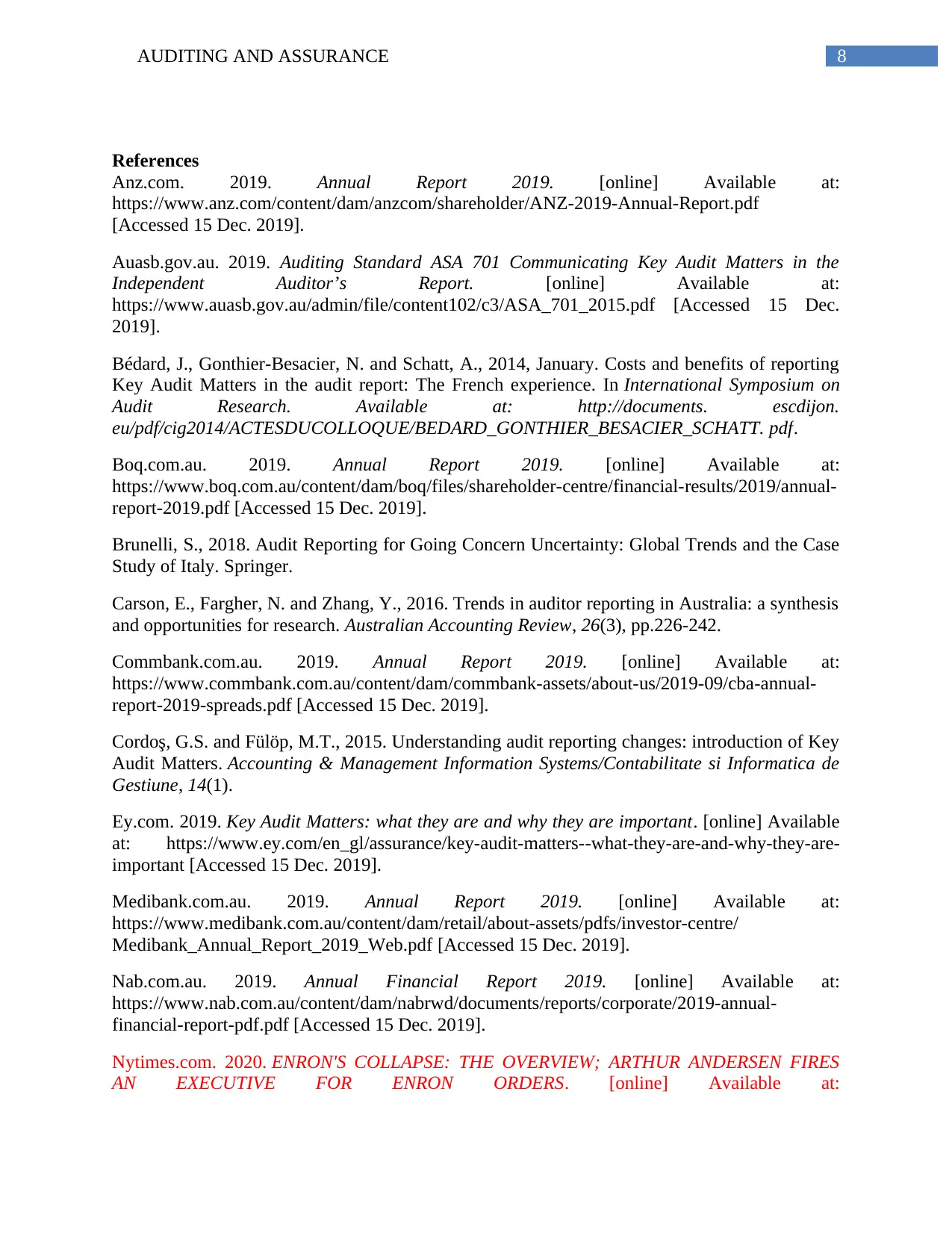
8AUDITING AND ASSURANCE
References
Anz.com. 2019. Annual Report 2019. [online] Available at:
https://www.anz.com/content/dam/anzcom/shareholder/ANZ-2019-Annual-Report.pdf
[Accessed 15 Dec. 2019].
Auasb.gov.au. 2019. Auditing Standard ASA 701 Communicating Key Audit Matters in the
Independent Auditor’s Report. [online] Available at:
https://www.auasb.gov.au/admin/file/content102/c3/ASA_701_2015.pdf [Accessed 15 Dec.
2019].
Bédard, J., Gonthier-Besacier, N. and Schatt, A., 2014, January. Costs and benefits of reporting
Key Audit Matters in the audit report: The French experience. In International Symposium on
Audit Research. Available at: http://documents. escdijon.
eu/pdf/cig2014/ACTESDUCOLLOQUE/BEDARD_GONTHIER_BESACIER_SCHATT. pdf.
Boq.com.au. 2019. Annual Report 2019. [online] Available at:
https://www.boq.com.au/content/dam/boq/files/shareholder-centre/financial-results/2019/annual-
report-2019.pdf [Accessed 15 Dec. 2019].
Brunelli, S., 2018. Audit Reporting for Going Concern Uncertainty: Global Trends and the Case
Study of Italy. Springer.
Carson, E., Fargher, N. and Zhang, Y., 2016. Trends in auditor reporting in Australia: a synthesis
and opportunities for research. Australian Accounting Review, 26(3), pp.226-242.
Commbank.com.au. 2019. Annual Report 2019. [online] Available at:
https://www.commbank.com.au/content/dam/commbank-assets/about-us/2019-09/cba-annual-
report-2019-spreads.pdf [Accessed 15 Dec. 2019].
Cordoş, G.S. and Fülöp, M.T., 2015. Understanding audit reporting changes: introduction of Key
Audit Matters. Accounting & Management Information Systems/Contabilitate si Informatica de
Gestiune, 14(1).
Ey.com. 2019. Key Audit Matters: what they are and why they are important. [online] Available
at: https://www.ey.com/en_gl/assurance/key-audit-matters--what-they-are-and-why-they-are-
important [Accessed 15 Dec. 2019].
Medibank.com.au. 2019. Annual Report 2019. [online] Available at:
https://www.medibank.com.au/content/dam/retail/about-assets/pdfs/investor-centre/
Medibank_Annual_Report_2019_Web.pdf [Accessed 15 Dec. 2019].
Nab.com.au. 2019. Annual Financial Report 2019. [online] Available at:
https://www.nab.com.au/content/dam/nabrwd/documents/reports/corporate/2019-annual-
financial-report-pdf.pdf [Accessed 15 Dec. 2019].
Nytimes.com. 2020. ENRON'S COLLAPSE: THE OVERVIEW; ARTHUR ANDERSEN FIRES
AN EXECUTIVE FOR ENRON ORDERS. [online] Available at:
References
Anz.com. 2019. Annual Report 2019. [online] Available at:
https://www.anz.com/content/dam/anzcom/shareholder/ANZ-2019-Annual-Report.pdf
[Accessed 15 Dec. 2019].
Auasb.gov.au. 2019. Auditing Standard ASA 701 Communicating Key Audit Matters in the
Independent Auditor’s Report. [online] Available at:
https://www.auasb.gov.au/admin/file/content102/c3/ASA_701_2015.pdf [Accessed 15 Dec.
2019].
Bédard, J., Gonthier-Besacier, N. and Schatt, A., 2014, January. Costs and benefits of reporting
Key Audit Matters in the audit report: The French experience. In International Symposium on
Audit Research. Available at: http://documents. escdijon.
eu/pdf/cig2014/ACTESDUCOLLOQUE/BEDARD_GONTHIER_BESACIER_SCHATT. pdf.
Boq.com.au. 2019. Annual Report 2019. [online] Available at:
https://www.boq.com.au/content/dam/boq/files/shareholder-centre/financial-results/2019/annual-
report-2019.pdf [Accessed 15 Dec. 2019].
Brunelli, S., 2018. Audit Reporting for Going Concern Uncertainty: Global Trends and the Case
Study of Italy. Springer.
Carson, E., Fargher, N. and Zhang, Y., 2016. Trends in auditor reporting in Australia: a synthesis
and opportunities for research. Australian Accounting Review, 26(3), pp.226-242.
Commbank.com.au. 2019. Annual Report 2019. [online] Available at:
https://www.commbank.com.au/content/dam/commbank-assets/about-us/2019-09/cba-annual-
report-2019-spreads.pdf [Accessed 15 Dec. 2019].
Cordoş, G.S. and Fülöp, M.T., 2015. Understanding audit reporting changes: introduction of Key
Audit Matters. Accounting & Management Information Systems/Contabilitate si Informatica de
Gestiune, 14(1).
Ey.com. 2019. Key Audit Matters: what they are and why they are important. [online] Available
at: https://www.ey.com/en_gl/assurance/key-audit-matters--what-they-are-and-why-they-are-
important [Accessed 15 Dec. 2019].
Medibank.com.au. 2019. Annual Report 2019. [online] Available at:
https://www.medibank.com.au/content/dam/retail/about-assets/pdfs/investor-centre/
Medibank_Annual_Report_2019_Web.pdf [Accessed 15 Dec. 2019].
Nab.com.au. 2019. Annual Financial Report 2019. [online] Available at:
https://www.nab.com.au/content/dam/nabrwd/documents/reports/corporate/2019-annual-
financial-report-pdf.pdf [Accessed 15 Dec. 2019].
Nytimes.com. 2020. ENRON'S COLLAPSE: THE OVERVIEW; ARTHUR ANDERSEN FIRES
AN EXECUTIVE FOR ENRON ORDERS. [online] Available at:
⊘ This is a preview!⊘
Do you want full access?
Subscribe today to unlock all pages.

Trusted by 1+ million students worldwide
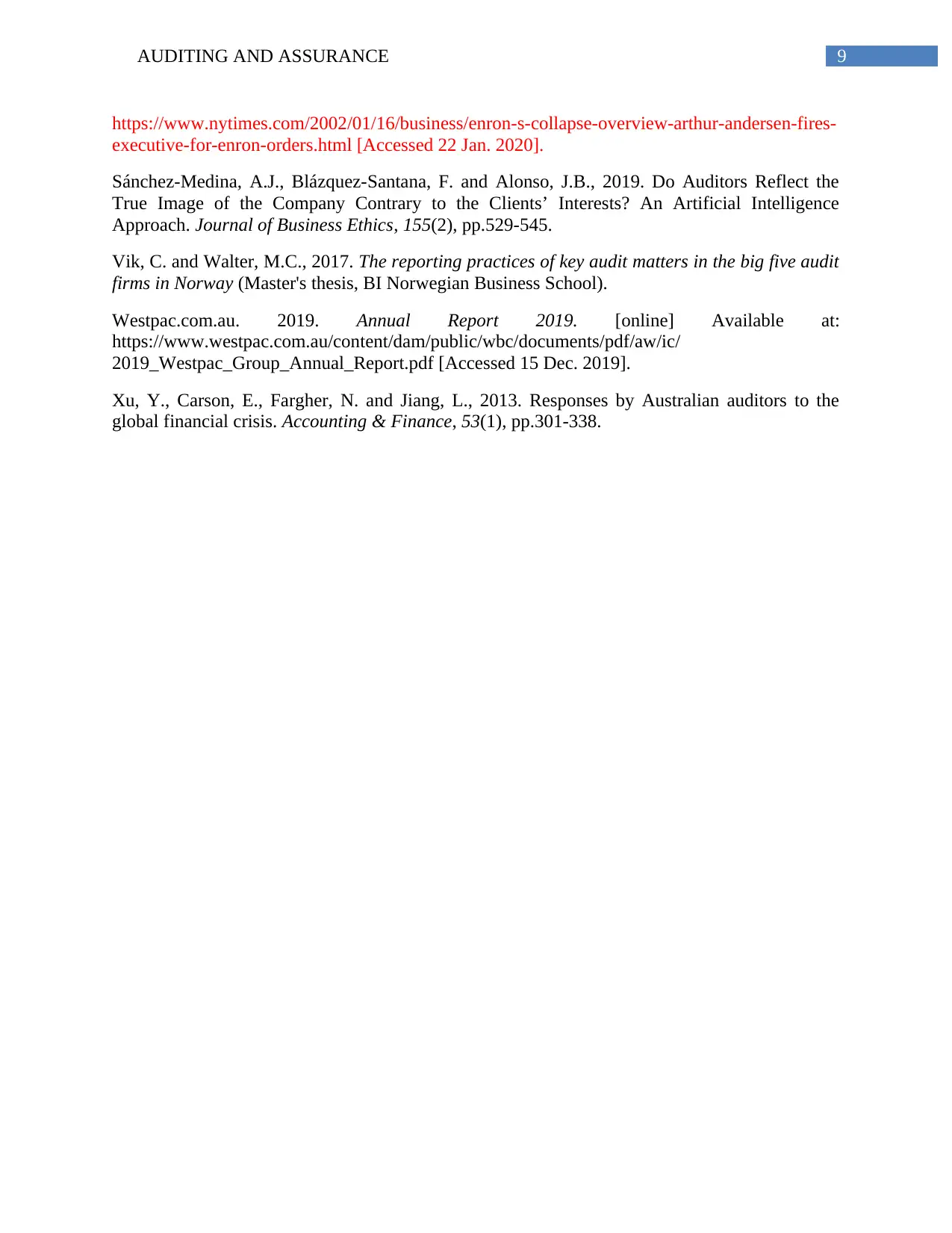
9AUDITING AND ASSURANCE
https://www.nytimes.com/2002/01/16/business/enron-s-collapse-overview-arthur-andersen-fires-
executive-for-enron-orders.html [Accessed 22 Jan. 2020].
Sánchez-Medina, A.J., Blázquez-Santana, F. and Alonso, J.B., 2019. Do Auditors Reflect the
True Image of the Company Contrary to the Clients’ Interests? An Artificial Intelligence
Approach. Journal of Business Ethics, 155(2), pp.529-545.
Vik, C. and Walter, M.C., 2017. The reporting practices of key audit matters in the big five audit
firms in Norway (Master's thesis, BI Norwegian Business School).
Westpac.com.au. 2019. Annual Report 2019. [online] Available at:
https://www.westpac.com.au/content/dam/public/wbc/documents/pdf/aw/ic/
2019_Westpac_Group_Annual_Report.pdf [Accessed 15 Dec. 2019].
Xu, Y., Carson, E., Fargher, N. and Jiang, L., 2013. Responses by Australian auditors to the
global financial crisis. Accounting & Finance, 53(1), pp.301-338.
https://www.nytimes.com/2002/01/16/business/enron-s-collapse-overview-arthur-andersen-fires-
executive-for-enron-orders.html [Accessed 22 Jan. 2020].
Sánchez-Medina, A.J., Blázquez-Santana, F. and Alonso, J.B., 2019. Do Auditors Reflect the
True Image of the Company Contrary to the Clients’ Interests? An Artificial Intelligence
Approach. Journal of Business Ethics, 155(2), pp.529-545.
Vik, C. and Walter, M.C., 2017. The reporting practices of key audit matters in the big five audit
firms in Norway (Master's thesis, BI Norwegian Business School).
Westpac.com.au. 2019. Annual Report 2019. [online] Available at:
https://www.westpac.com.au/content/dam/public/wbc/documents/pdf/aw/ic/
2019_Westpac_Group_Annual_Report.pdf [Accessed 15 Dec. 2019].
Xu, Y., Carson, E., Fargher, N. and Jiang, L., 2013. Responses by Australian auditors to the
global financial crisis. Accounting & Finance, 53(1), pp.301-338.
1 out of 10
Related Documents
Your All-in-One AI-Powered Toolkit for Academic Success.
+13062052269
info@desklib.com
Available 24*7 on WhatsApp / Email
![[object Object]](/_next/static/media/star-bottom.7253800d.svg)
Unlock your academic potential
Copyright © 2020–2025 A2Z Services. All Rights Reserved. Developed and managed by ZUCOL.





